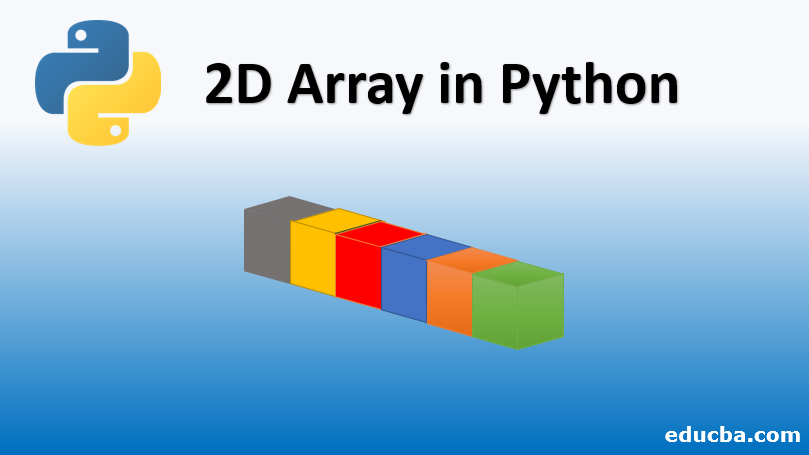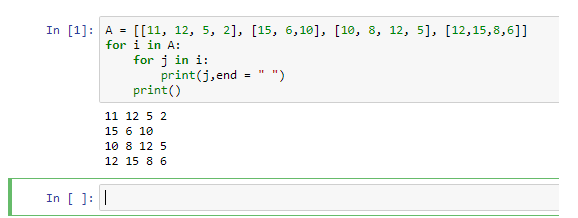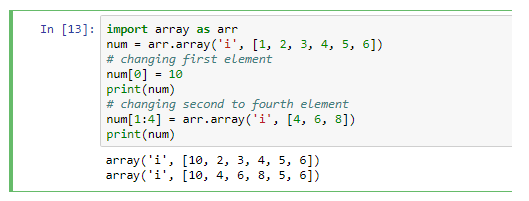How to Read Text File in Python to Make 2d Array

Introduction to 2D Arrays In Python
Arrangement of elements that consists of making an array, i.due east. an array of arrays within an assortment. A type of assortment in which 2 indices refer to the position of a data element as against just ane, and the unabridged representation of the elements looks like a tabular array with data being arranged as rows and columns, and it can be effectively used for performing from simplest operations like addition, subtraction to toughest tasks like multiplication and inverse operations. In the context of data analysis, based on the requirement, they are termed every bit two-dimensional arrays in the Python programming language.
Let u.s. have an case, where we have to measure the tiptop and weight of 4 people.
Person 1: half-dozen.0 ft 61 kg
Person 2: 5.three ft 53 kg
Person 3: 5.9 ft 67 kg
Person 4: half-dozen.2 ft 63 kg
So the above set of information tin exist represented with the help of a ii-dimensional array in the following way.
A= [[6, 61], [5.3, 53], [5.9, 67], [6.2, 63]]
Different operations in 2d arrays in Python
Here we Explicate Different Operations in 2D arrays in Python along with Examples.
- Create
- Insert
- Update
- Delete
Creating an array
Allow us see how we can create a 2d array in Python
Method one – Hither, nosotros are not defining the size of rows and columns and directly assigning an assortment to some variable A.
A = [[xi, 12, 5, 2], [15, 6,ten], [ten, 8, 12, 5], [12,15,8,half dozen]] for i in A:
for j in i:
print(j,end = " ")
print()

Method 2– Here, we will exist defining the size of the array and then will try to do some basic operations and and then nosotros volition impress our array.
rows, cols = (five, five)
arr = [[0]*cols]*rows
print(arr)

Method 3 – In this method, we volition exist asking the users input to know the number of rows and columns; we can employ the input method for taking the user's input.
row = int(input("Input the number of rows: "))
col = int(input("Input the number of columns: "))
list = [[0 for col in range(col)] for row in range(row)] for row in range(row):
for col in range(col):
listing[row][col]= row*col
 
print(listing)

Inserting elements to an array
Here, we have defined an assortment with the name "cars", and as in the first line of the code, the elements of the array are Ford, Volvo, and BMW. Now suppose, if we would similar to add more than elements to the array, we tin can make utilize of the append office. In the third line of the lawmaking, we take used the append role to add together another car element, "Bugatti", to the existing array. And so nosotros take printed the array.
cars = ["Ford", "Volvo", "BMW"] print(cars)
cars.append("Bugatti")
print(cars)

Well, what if we would desire to add several elements at a time to the array and not merely i?
In that scenario, nosotros tin make use of the extend function.
cars = ["Ford", "Volvo", "BMW"] print(cars)
cars.append("Bugati")
print(cars)
cars.extend(["RangeRover", "Lambhorghini"])
print(cars)

Equally we can see hither, we accept used extend role to add multiple elements to the assortment at once, and and then we have printed our assortment. It is also possible to concatenate to unlike arrays.
cars1 = ["Ford", "Volvo", "BMW"] cars2=["Lambo", "RangeRover"] car = cars1 + cars2
print(car)
Here, we take defined two different arrays with name cars1 and cars2, and nosotros have and so added these 2 arrays and stored inside an assortment called the car, and so we take simply printed the car assortment. The final issue has the elements from both the arrays.

Update/Changing assortment elements
In this section, nosotros will try to update and alter the elements of the array. Arrays are mutable and the elements of an array can exist changed. Below is an example of how nosotros can do this
import array equally arr num = arr.assortment('i', [ane, 2, iii, 4, 5, 6])# irresolute the first element
num[0]= 10print(num)
# changing 2nd to the 4th elementnum[1print(num)
As we run across, we have starting time created an array called "num". Nosotros have replaced the kickoff element of the assortment with the number 10, and so we take printed the array. Next, we accept inverse the assortment elements from the 2d position to the fourth position, then nosotros take printed it.
Accessing the assortment elements
We can access elements of the array by specifying the alphabetize position. In the below example, we have created an array of numbers, and and so we have printed the very first element of the array past specifying the index position with square braces of num array. The index in an array starts at 0, and information technology increments by 1 as nosotros go through. We can also directly access the last chemical element of the array by specifying the alphabetize as -1 (minus 1).
import array as arr
num = arr.array('i', [1, ii, 3, 4])
print("First element:", num[0])
print("2d element:", num[one])
print("Final element:", num[-one])

Removing Array Elements
We can remove elements from the array by making use of the del office and specifying the index position for which we would similar to delete the array element.
For instance,
import array as arr
num = arr.array('i', [2, 3, four, 5, 6])
del num[3] # removing the 4th element
print(num)

Determination
In this section, nosotros have learned dissimilar operations that can be performed on an array. Nosotros take started with created an assortment and saw dissimilar ways to create an array; then we saw how we could add an chemical element to the assortment, how to alter or update elements of an array, how to access the elements of an assortment, and finally, nosotros learned how to remove the array elements or how to delete the unabridged array itself.
Recommended Article
This has been a guide to 2d Arrays In Python. Here we talk over Unlike operations in second arrays in Python along with Method, Lawmaking, and Output. Y'all can also become through our other suggested manufactures to larn more –
- 3d Arrays in Python
- 2d Arrays in Java
- two-D Arrays in C
- 2nd Arrays in C#
Source: https://www.educba.com/2d-arrays-in-python/
0 Response to "How to Read Text File in Python to Make 2d Array"
Post a Comment